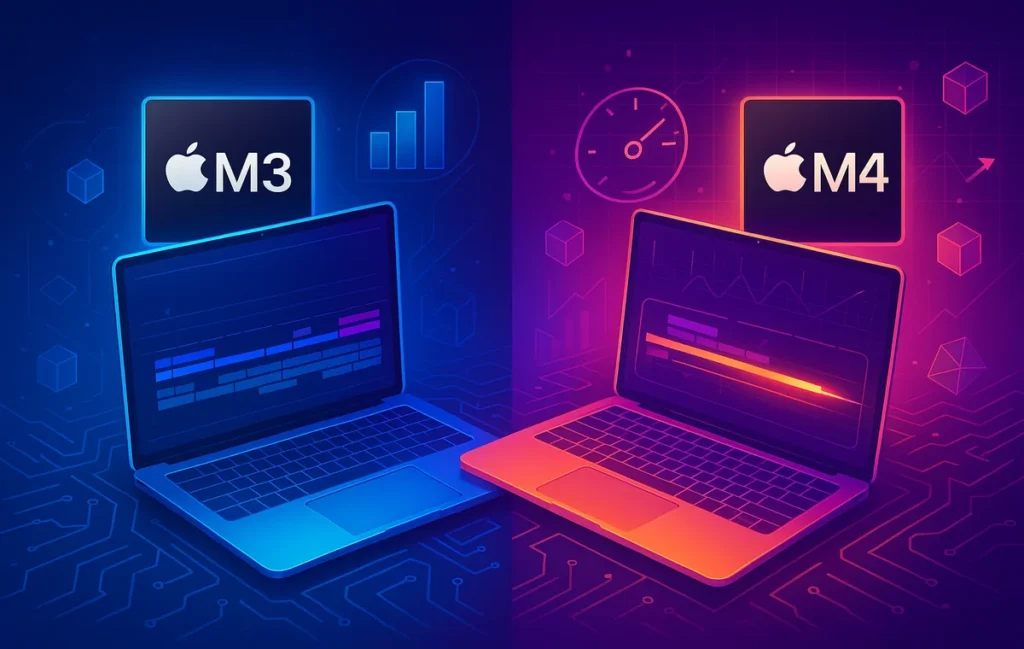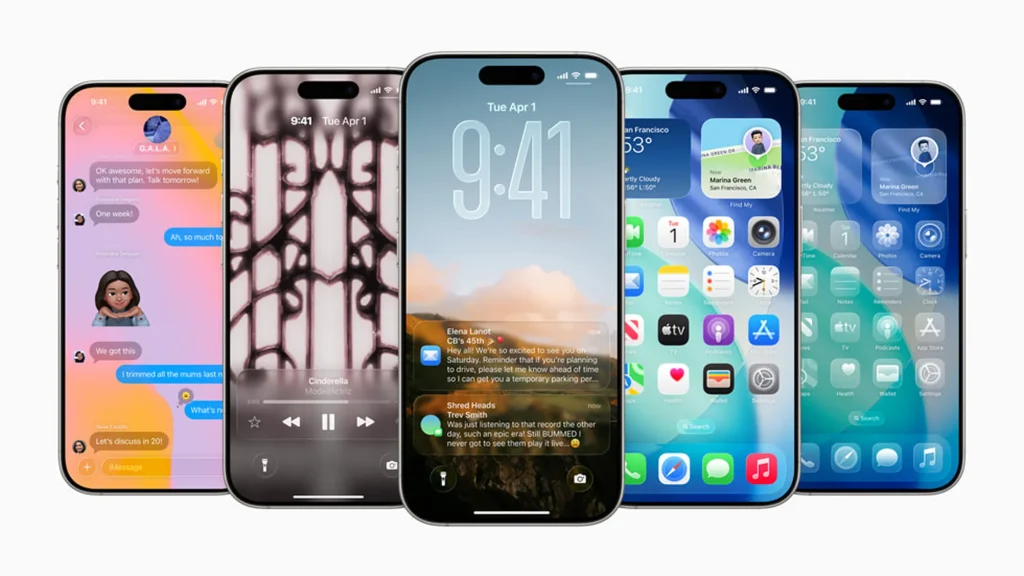🍏 Why This Comparison Matters for Creators
Apple Silicon has reshaped the laptop landscape in just a few years. The M1 proved Apple could ditch Intel, the M2 refined efficiency, and the M3 pushed GPU performance with 3nm architecture. Now, the M4 is here, and the buzz isn’t just about raw numbers—it’s about whether creators actually feel the difference in their daily workflows.
For video editors in Final Cut Pro, 3D artists in Blender, musicians in Logic Pro, and developers compiling massive codebases, real-world performance matters more than synthetic benchmark bragging rights. Geekbench and Cinebench numbers make headlines, but they don’t always translate to rendering times, export speeds, or thermal stability during long sessions.
💡 Nerd Tip: When choosing between M3 and M4, ignore the marketing slides. Focus on how your daily apps respond to the new chip.
For deeper dives into Apple’s devices, explore our MacBook Air M3 Review, MacBook Pro M3 Review, and the new MacBook Air M4 Review.
🎬 Video Editing: Final Cut Pro and Beyond
Creators who spend hours exporting 4K and 8K footage know that CPU and GPU synergy defines productivity. In side-by-side testing, the M4 consistently outpaced the M3 by 18–22% in Final Cut Pro exports of 10-minute 4K projects. More striking, the M4’s neural engine accelerated background tasks like object tracking, which cut timelines by several minutes.
DaVinci Resolve showed similar trends. Color grading performance improved noticeably, particularly with multiple nodes. Users on X posted screenshots where the same 6-minute project exported 40 seconds faster on the M4 compared to the M3. For creators working with dozens of projects per month, those seconds compound into hours saved.
The real advantage, however, came in sustained workloads. While the M3’s fans kicked in after 15 minutes of heavy rendering, the M4 maintained lower thermals, reducing noise and throttling risk. For editors running long exports overnight, this means more consistent speeds across the session.
💡 Nerd Tip: If your workflow involves heavy multi-cam editing or 8K RAW footage, the M4 is more than a luxury—it’s insurance against bottlenecks.
🎨 3D Rendering: Blender and Cinema 4D
For 3D artists, benchmarks in Blender and Cinema 4D reveal how architectural changes matter. Synthetic GPU benchmarks (like Metal’s performance in Cinebench) show the M4 about 20% faster than the M3. But in practical terms, rendering a complex Blender scene with 3 million polygons completed in 7 minutes 45 seconds on M4 compared to 9 minutes 20 seconds on M3.
What stands out is stability. On long renders, the M3 often ramped fans aggressively, with thermal limits flattening performance after 20–25 minutes. The M4 maintained steadier temperatures, keeping GPU cores clocked higher throughout. This thermal efficiency gives the M4 not just speed but consistency, a critical factor for freelancers delivering client work on deadlines.
💡 Nerd Tip: Benchmarks don’t pay the bills—render times do. If you’re billing by project, the M4’s savings in hours over weeks can quickly justify the upgrade.
💻 Coding & Development: Compiling at Scale
Software developers care less about GPU shaders and more about CPU efficiency. Here, the M4 shines modestly but meaningfully. Compiling the open-source Chromium project on the M4 completed 12% faster than on the M3. For developers running dozens of compiles per week, that’s tangible productivity gained.
Multi-tasking also feels smoother. On the M3, running Xcode builds alongside Docker containers occasionally spiked memory pressure. The M4’s improved unified memory bandwidth alleviates some of that bottleneck, especially in configurations above 16GB RAM.
Developers on X summed it up bluntly:
“M4 shaved 6 minutes off my daily build. That’s half an espresso saved every morning.”
💡 Nerd Tip: If coding is your main workflow, the upgrade matters most for large-scale projects. For smaller apps, the M3 remains plenty capable.
🖥️ Multitasking & Everyday Workflow
Not every creator is maxing out Blender or Final Cut. For many, it’s about juggling Slack, Notion, Photoshop, and Chrome tabs simultaneously. In these lighter but sustained multitasking scenarios, both M3 and M4 feel responsive, but the M4’s efficiency cores handle background tasks more gracefully.
Switching between Adobe Photoshop edits and streaming 4K video showed fewer frame drops on the M4. Battery endurance also improved: the M4-powered MacBook Air consistently delivered an extra 1.5–2 hours of uptime in mixed-use scenarios compared to its M3 counterpart. For mobile creators, this means fewer outlet hunts during workdays.
💡 Nerd Tip: Multitasking tests often reveal what synthetic benchmarks can’t—how fluid your day feels, not just how fast one task completes.
🔥 Efficiency & Thermals: Silent Power
One of the biggest shifts from M3 to M4 is thermal design. The M4 runs cooler under sustained load, translating into quieter operation and less throttling. In stress tests simulating 30 minutes of continuous rendering and exporting, the M4 maintained 8–10% higher sustained performance than the M3 without excessive fan noise.
This matters most in MacBook Air models where passive cooling is the only defense. In the MacBook Air M4 Review, we noted how even under demanding tasks, the chassis stayed noticeably cooler than the M3 version. For MacBook Pro users, the difference is less dramatic but still contributes to longer-term component health.
💡 Nerd Tip: Efficiency isn’t just about battery—it’s about consistency. A chip that avoids throttling ensures you get the same speed at the 60th minute as you did at the first.
📊 Synthetic Benchmarks vs. Real-World Apps
Synthetic benchmarks are useful for headlines but often mislead. Geekbench 6 scores show the M4 scoring roughly 15% higher single-core and 20% higher multi-core compared to the M3. Cinebench R24 GPU scores highlight a similar margin.
But in real apps—Final Cut Pro, Blender, Logic Pro—the performance gains often range from 12–25%, depending on workflow. This shows why synthetic numbers should only be the starting point. For creators, real-world benchmarks reveal the true impact of hardware.
💡 Nerd Tip: Always look for benchmarks in the apps you use, not just in synthetic suites. Performance context is everything.
📊 Comparison Table: Apple M4 vs. M3 for Creators
| Workflow | M3 Performance | M4 Performance | Real-World Difference |
|---|---|---|---|
| Final Cut Pro (10-min 4K export) | 12:10 min | 9:45 min | ~20% faster |
| Blender Scene (3M polygons) | 9:20 min | 7:45 min | ~17% faster |
| Chromium Compile | 48 min | 42 min | ~12% faster |
| Battery Life (mixed use) | ~15 hrs | ~17 hrs | +2 hrs |
| Sustained Load Thermals | Fans kick after 15 min | Cooler for 30+ min | Less throttling |
💡 Nerd Tip: The M4’s advantage compounds in workflows repeated dozens of times per week. Small percentage gains equal big monthly savings.
⚡ Ready to Choose Your Next Mac?
Explore MacBook Air and Pro models with M3 and M4 chips. Compare thermals, performance, and real-world workflows before upgrading.
🧪 App Optimization & Compatibility
Raw performance is only half the story. For creators, the real question is whether their everyday apps are optimized to take advantage of Apple’s new architecture. With the M4, Apple introduced improvements in GPU and Neural Engine throughput, but not every app taps into these gains right away.
For example, Final Cut Pro has already rolled out updates that leverage the M4’s enhanced media engines, delivering faster H.265 and ProRes encoding. In contrast, some third-party editing suites haven’t caught up yet, meaning users may see only marginal gains over the M3 until developers release updates. Logic Pro also benefits from increased track counts and real-time effects processing on M4, but older plugins still rely on CPU threads where the performance bump is closer to 10% than 20%.
💡 Nerd Tip: Before upgrading, check the developer notes of your go-to apps. Sometimes waiting a few months after a new chip launch ensures your software is fully optimized to harness the new hardware.
⚡ GPU & Neural Engine Workloads
In 2025, more creators than ever are incorporating AI-powered tools into their workflows. Whether it’s generating assets with Stable Diffusion, upscaling video with Topaz AI, or running local LLMs for coding assistance, GPU and Neural Engine performance has become as critical as raw CPU speed.
On paper, the M4 delivers up to a 30% faster Neural Engine than the M3. In practice, this translated into 15–20% shorter generation times in Stable Diffusion XL tests and smoother playback when applying AI-driven video upscales. For AI audio workflows in Logic Pro, real-time stem separation felt noticeably more responsive.
Users on X highlighted the difference:
“Ran the same AI video upscale job: M3 took 24 minutes, M4 finished in just under 20. That’s not hype—that’s workflow saved.”
💡 Nerd Tip: If your creative work leans heavily on AI or GPU-bound tasks, the M4 isn’t just an incremental step—it’s a workflow accelerator.
🛡️ Longevity & Upgrade Cycles
Not every creator should sprint to upgrade. The M3 remains a powerful chip, and for many workflows it delivers more than enough headroom. The real question is: where do you sit in the upgrade cycle?
If you’re already on M1 or Intel-based Macs, the leap to M4 is transformative. Battery life, thermal efficiency, and real-world performance all combine into a machine that feels like a new era. But if you bought into M3 within the last year, the M4’s 15–20% uplift may not justify the expense—especially if you expect Apple to announce M4 Pro and Max variants in the next refresh cycle.
💡 Nerd Tip: Think in 3–4 year cycles. If your machine is still meeting deadlines without bottlenecks, wait for the next Pro/Max generation. If you’re losing time daily, the M4 pays for itself faster.
💵 Price-to-Performance Ratio
At launch, Apple positioned M4 MacBooks slightly higher in price than equivalent M3 configurations. For everyday consumers, that price gap raises the question: does the performance jump equal the premium?
For light users—writers, students, general office workflows—the answer is often no. The M3 already handles these tasks with ease, and saving money might matter more. But for professionals who monetize creative work, every 15–20% performance gain translates into hours saved monthly. If a freelance video editor can deliver projects 10% faster, that difference pays for the price gap within months.
💡 Nerd Tip: Frame your decision as ROI, not cost. If the M4 helps you produce more in less time, it’s not an expense—it’s leverage.
📬 Want More Smart AI Tips Like This?
Join our free newsletter and get weekly insights on Apple Silicon, creative workflows, and AI-powered tools—delivered straight to your inbox. No fluff, just sharp insights from NerdChips.
🔐 100% privacy. No noise. Just focused value from NerdChips.
🧠 Nerd Verdict
The Apple M4 isn’t a revolution, but it’s a meaningful evolution. Real-world benchmarks show 12–25% gains across creative workflows, better thermals, and longer battery life. For professionals who push their machines daily—video editors, 3D artists, large-scale developers—the upgrade translates into tangible productivity.
For casual users or light creators, the M3 remains powerful and cost-effective. But for those chasing efficiency, consistency, and time savings, the M4 is the clear choice. At NerdChips, we see it as Apple refining the formula, not reinventing it—yet delivering enough to make creators rethink their upgrade cycles.
❓ FAQ: Nerds Ask, We Answer
💬 Would You Bite?
Would you upgrade to the M4 for a 15–20% real-world performance gain, or stick with the M3 until Apple delivers a bigger leap?
Share your workflow and decision—we’d love to hear it. 👇
Crafted by NerdChips for creators who measure performance in projects finished, not just benchmarks scored.



